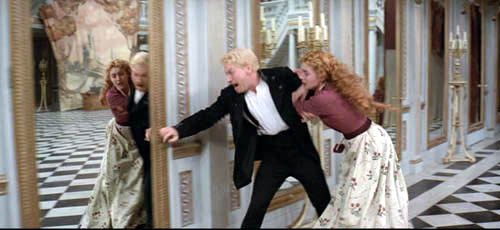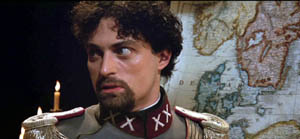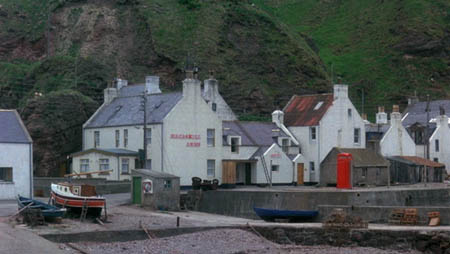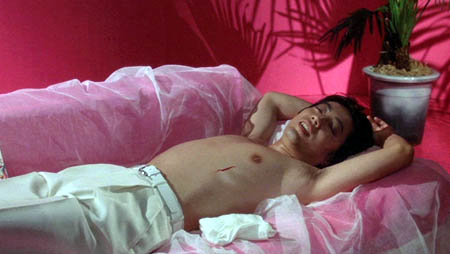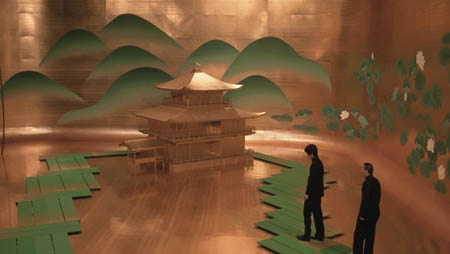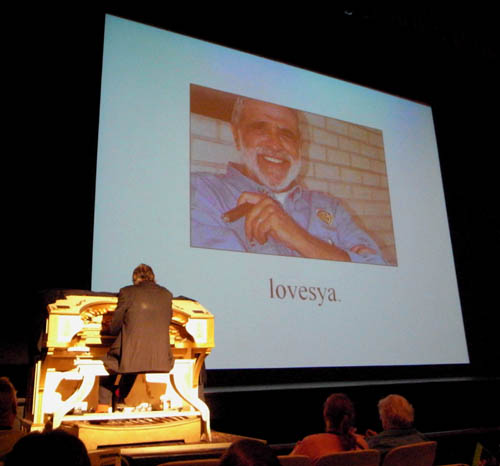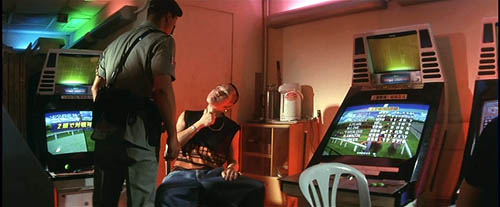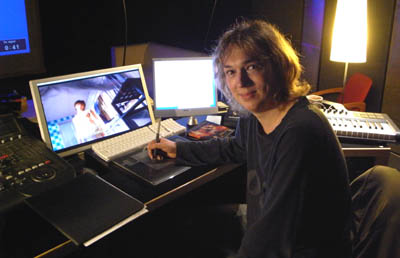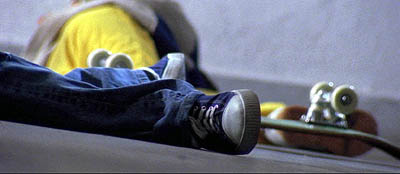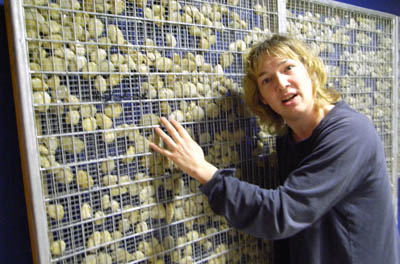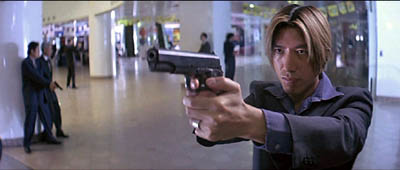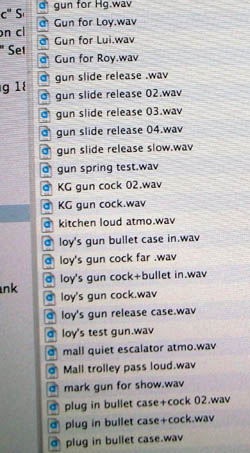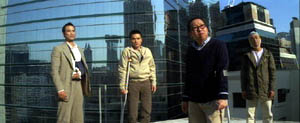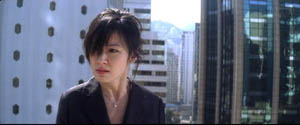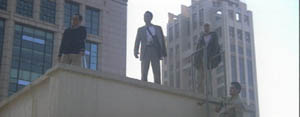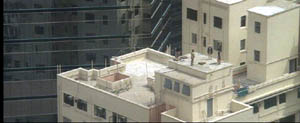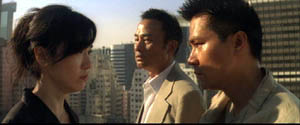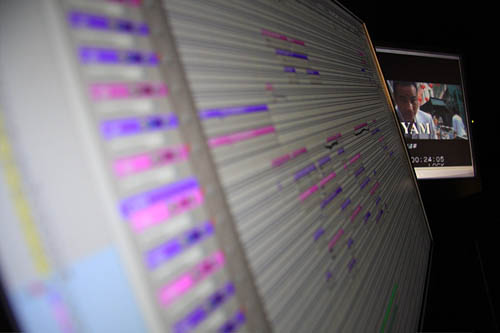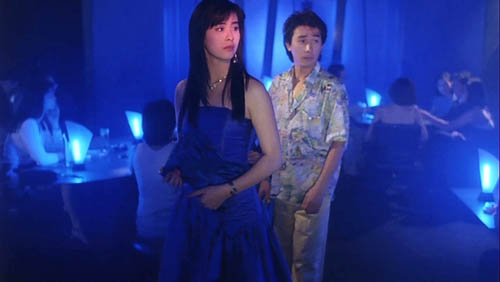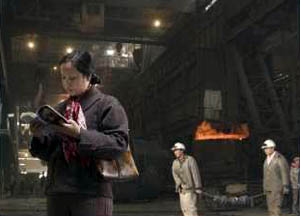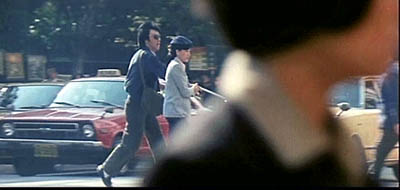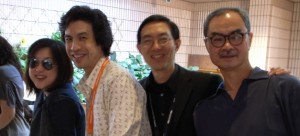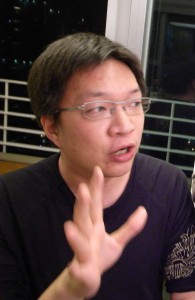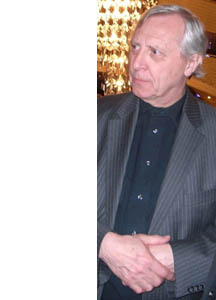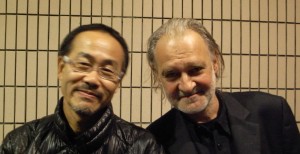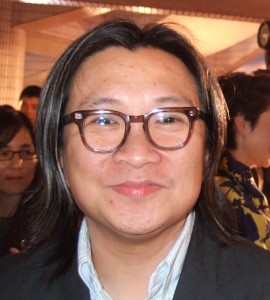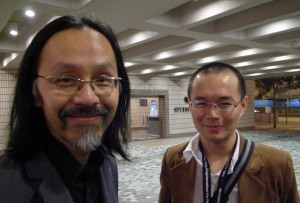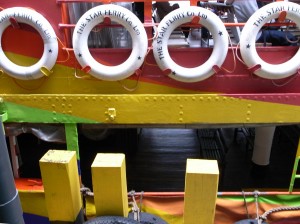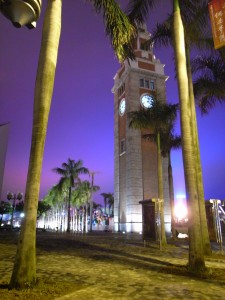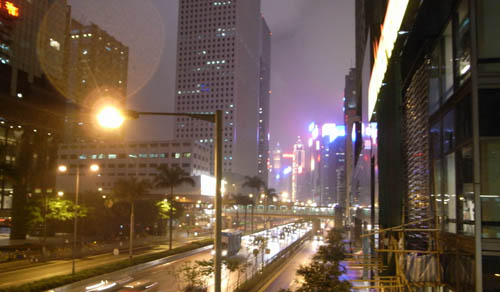Archive for April 2008
The show goes on
DB here:
Kristin and I had hoped to blog directly from this year’s edition of Ebertfest (formerly Roger Ebert’s Festival of Overlooked and Forgotten Films), but our blogging software failed us. We could post text but no pictures, and where’s the fun in that? Fortunately, the event was widely covered. The schedule, with very full film notes, is here. You can get a sense of what was happening by checking Jim Emerson at scanners and Peter Sobczynski at Hollywood Bitchslap and Kim Voynar at Cinematical and Lisa Rosman at A Broad View and P. L Kerpius at Scarlett Cinema and Andrew Wells at A Penny in the Well and many others. There is some coverage at the News Gazette, although the most informative stories from the paper aren’t on the net. Then there’s Roger’s own blog, Ebertfest in Exile, which in one entry goes off on an unexpected trajectory….toward Joe vs. the Volcano.
Now that we can again illustrate our entry, we offer you an ex post facto blog, like last year’s, which makes up in bulk for its tardiness. I hope to follow soon with a picture gallery.
This year’s Ebertfest lacked an essential ingredient: Roger Ebert. But Chaz Ebert took over hosting duties superbly, aided by the terrific organizational skills of Nate Kohn and Mary Susan Britt. At every screening, one person or another paid tribute to Roger’s gifts to film culture—his writing, of course, but also his tireless championing of deserving movies that should be brought to wider audiences.
The format of Ebertfest offers something for everyone. Traditionally, the opening night is an older film screened in classic 70mm, a format that’s almost vanished. Past years have included shows of Lawrence of Arabia, Play Time, and My Fair Lady. 70mm looks gorgeous on the vast screen of the Virginia Theatre. This year the film was Kenneth Branagh’s Hamlet, at four hours the most complete version of the play ever put on film. It looked grand.
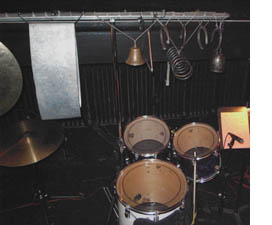 Another slot is reserved for a silent movie, often accompanied by the Alloy Orchestra. (Part of their armory, including bells, springs, and a thunderstrip, can be found on the left.) Having programmed The Black Pirate, The General, and The Eagle in earlier years, Roger picked von Sternberg’s sumptuous Underworld (1927), which Kristin introduced and led a discussion about. The Alloy boys’ scores are getting more nuanced by the year, and this one did as much justice to von Sternberg’s quiet passages as to the gunplay.
Another slot is reserved for a silent movie, often accompanied by the Alloy Orchestra. (Part of their armory, including bells, springs, and a thunderstrip, can be found on the left.) Having programmed The Black Pirate, The General, and The Eagle in earlier years, Roger picked von Sternberg’s sumptuous Underworld (1927), which Kristin introduced and led a discussion about. The Alloy boys’ scores are getting more nuanced by the year, and this one did as much justice to von Sternberg’s quiet passages as to the gunplay.
Yet another Ebertfest mainstay is a children’s show on Saturday morning, and last year’s wonderful Holes was followed by an unexpected pick—Ang Lee’s Hulk, with the director in attendance. The place was packed, Lee was his charming self, a trio serenaded him, and the audience left well-pleased.
Prime spots are reserved for less-known films, with an emphasis on independent and personal cinema. We saw Tom DiCillo’s Delirious, Sally Potter’s Yes, Joe Greco’s Canvas, and Jeff Nichols’ Shotgun Stories. A highlight for me was Eran Kolirin’s The Band’s Visit, which I’d missed elsewhere. This unassuming, warm, funny movie recalled Tati and 1960s Czech films like Intimate Lighting. Then there was The Cell by Tarsim Singh at a late-night screening, with John Turturro’s Romance and Cigarettes to wrap things up on Sunday. For kaleidoscopic commentary on all these, see the above-mentioned weblogs.
Princely contradictions
I hadn’t seen Hamlet in 70mm in its initial 1996-1997 run, and at first the idea of taking this fairly intimate piece to a wide-film format seemed counterintuitive. But on the Virginia screen the film lost none of the play’s intensity and it gained a welcome monumentality. The central set, the Danish throne room as a gigantic hall of mirrors flanked by a warren of corridors and fissured by secret passageways, is made for the wide image.
Scale of time also matters. By playing the full version, Branagh can give full weight to the father/ son parallels that riddle the play. If Olivier’s Hamlet was about a son’s love for his mother, Branagh makes the play about the strife between fathers and sons, with women caught in the middle. Hamlet Sr./ Hamlet Jr., Claudius/ Hamlet, Jr., Polonius/ Laertes, old Norway/ Fortinbras, and even the Player’s speech about the murder of Priam: the parallels are in Shakespeare’s text but played out at proper length they snap into sharp relief. Once Laertes is off to Paris, Polonius makes sure he’s spied on, just as Claudius orders Rosenkrantz and Guildenstern to watch Hamlet. In his turn, Hamlet assigns Horatio surveillance duty during the play-within-a-play (a piece of action nicely caught in the opera glasses that Branagh’s choice of period allows). Branagh’s decision to emphasize the military politics around Fortinbras’ march into Denmark helps justify the 70mm format and his decision to set the action in late nineteenth-century Europe; it also allows him to expand, through crosscutting set up early in the movie, the plot of another son at odds with his father.
Sex is important in this game. Branagh presents flashbacks to Hamlet and Ophelia in bed together, accentuating the prince’s later indifference and motivating her despair at his rejection. Not that the fathers don’t clock some mattress time too. Claudius the urbane politician becomes an infatuated newlywed, and Derek Jacobi gives to my mind a definitive performance. Even Polonius, usually treated as a pompous ass, smokes worldly little cigars and has a drab tucked into his bed, so that his advice to Laertes and Ophelia about proper conduct becomes not only patronizing but hypocritical.
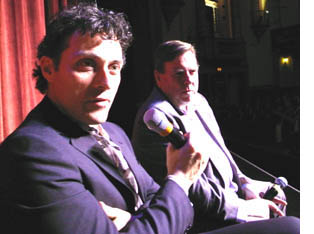 During the Q & A, Timothy Spall and Rufus Sewall emphasized something that Branagh explains on the DVD set: the need to create ensemble performances out of footage shot at different times. Sewall (a dark and scary Fortinbras) was filmed in a few days, before full-blown production, with his bits cut into the film at intervals. Robin Williams, as Osric, was also filmed out of continuity; there are scarcely any shots of him in the same frame as other players.
During the Q & A, Timothy Spall and Rufus Sewall emphasized something that Branagh explains on the DVD set: the need to create ensemble performances out of footage shot at different times. Sewall (a dark and scary Fortinbras) was filmed in a few days, before full-blown production, with his bits cut into the film at intervals. Robin Williams, as Osric, was also filmed out of continuity; there are scarcely any shots of him in the same frame as other players.
Spall, a temporizing Rosenkrantz, was present for much more of the filming and was eloquent in explaining how shooting in long, wheeling takes demanded great precision from the actors—hitting marks, using body language, and timing speeches carefully.
Branagh put the bulky 70mm camera on a dolly, then reinforced the studio floors so that no tracks or boards were necessary; the camera could glide anywhere. “Walk and talk” technique, which I’ve blogged about before, comes home to roost in a Shakespeare film; Branagh wanted continuous shots so that the audiences could follow the flow of the speeches, and it works very well.
In fact, Branagh’s editing varies in a patterned way across the play. Acts I and III are briskly cut, averaging about 5 seconds per shot. Acts II and IV rely on much longer takes, typified by the tracking-shot arabesques, and they average 10-11 seconds per shot. And Act V? Here, as you might expect, Branagh pushes the pace to suit the converging plotlines and the burst of poisonings at the climax: the average shot runs about 3 seconds. This seesawing rhythm helps sustain viewer interest across four hours, and it shows an unusually geometrical approach to a movie’s overall architecture.
In his program review, Roger points out that the play remains deeply mysterious, even in a production as lucid and buoyant as Branagh’s. Hamlet is of course one of the most fascinatingly inconsistent characters in literature. I’ve read the play probably a dozen times and seen many film versions of it, and I’m inclined to think that in Hamlet Shakespeare is experimenting with how indeterminate a character can be and still be intelligible to us. It’s not that he’s indecisive; we have to decide what he truly is, and Shakespeare makes our task very hard.
All the other characters in the play are complicated but consistent. Only Hamlet seems to reinvent himself at every entrance. He tells us that he will put on an “antic disposition,” but before he’s gotten very far with his fake madness, he tells Rosenkrantz and Guildenstern of his strategy, knowing that they are likely to report it to Claudius. This has the effect of letting Hamlet behave any way he wants, sincere or duplicitous, calculating or mad. When he’s around others, he’s always “on,” and this makes his true nature and purposes difficult to divine.
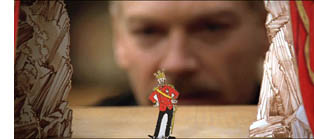 I liked Branagh’s idea of having Hamlet consulting a book on demonology, for in a revenge tragedy the protagonist has to be sure that the aggrieved spirit urging revenge isn’t a demon in disguise. More generally, the Victorian milieu lets Branagh give us a truly bookish Hamlet, one who retreats to his stuffed library when overcome by the strife unfolding in the vast throne room. At the same time, that library contains players’ masks and a curious miniature theatre that Hamlet toys with thoughtfully. He lives among books, but also among images of pretense and deceit.
I liked Branagh’s idea of having Hamlet consulting a book on demonology, for in a revenge tragedy the protagonist has to be sure that the aggrieved spirit urging revenge isn’t a demon in disguise. More generally, the Victorian milieu lets Branagh give us a truly bookish Hamlet, one who retreats to his stuffed library when overcome by the strife unfolding in the vast throne room. At the same time, that library contains players’ masks and a curious miniature theatre that Hamlet toys with thoughtfully. He lives among books, but also among images of pretense and deceit.
The questions tease you right to the end. Hamlet finds Laertes’ plunge into Ophelia’s grave overdramatic, but he goes on to declare that he himself loved her with the strength of forty brothers. Before the climactic duel, Hamlet apologizes to Laertes (“I have shot my arrow o’er the house/ And hurt my brother”), but it seems almost bad faith, given all the misery he has helped cause. Is this a morally obtuse sincerity, or another masquerade? It’s this Hamlet, reliably unpredictable, that Branagh’s manic-depressive performance brings home so forcefully.
The unwitting wisdom of the suits
It’s common to say now that the 1970s was the last great era in American cinema, followed by the degradations of the blockbuster 80s, but that remains little more than PR. Putting aside the “revolution” of the 1970s, which seems to me overrated, I’ll just offer the opinion that the 1980s brought us many worthy films, some of them quite daring. For example, one of the sweetest “little movies” of the era is Bill Forsyth’s Local Hero (1983).
It’s a comedy, at once dry and warm, about an oil executive sent to buy a small Scottish town and beachfront in preparation for the installation of a pumping rig and refinery. Forsyth’s script reverses the cliché. The townsfolk, far from clinging to their beloved tradition, are in fact anxious to sell and look forward to being rich. The young executive, Mac, doesn’t try to drive a hard bargain but settles into the rhythm of a life different from that he has known. His boss, a passionate amateur astronomer, surprises everyone with his final decision about the deal. You might call Local Hero one of the first films about the clash of global capitalism and community values, but though that’s accurate, the schematic formula doesn’t capture the understated humor and humanity of Forsyth’s treatment.
Forsyth is at Ebertfest for a screening of his no less brilliant Housekeeping; see Jim Emerson’s eloquent and poised review here. But I wanted to ask about Local Hero. The Scottish village is rendered with the affectionate good humor we find in Ealing comedies, and Forsyth mentioned that after he’d made the film he discovered an Alexander Mackendrick movie, The Maggie (1955), that prefigured his. For me, there were echoes of Jacques Tati in the long-shots and sound gags, and Forsyth confirmed that one of the formative films in his youth was M. Hulot’s Holiday, screened by an indulgent school head.
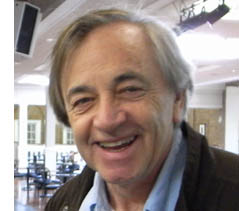 Forsyth talked about certain choices he made. The Mark Knopfler score, bringing together Scottish tunes and a Texas twang, helped open out the film in a way that a more conventional lyrical score would not. Forsythe talked as well about the final shot, one of the most satisfying I’ve ever seen. The original cut ended with Mac returning to his Houston apartment and staring out at the dark urban landscape—beautiful in its own way, but very different from the majesty of the Scottish shore. There the original film ended, but the Warners executives, although liking the film, wanted a more upbeat ending. Couldn’t the hero go back to Scotland and find happiness, you know, like in Brigadoon? They even offered money for a reshoot to provide a happy wrapup. Forsyth didn’t want that, of course, but he had less than a day to find an ending.
Forsyth talked about certain choices he made. The Mark Knopfler score, bringing together Scottish tunes and a Texas twang, helped open out the film in a way that a more conventional lyrical score would not. Forsythe talked as well about the final shot, one of the most satisfying I’ve ever seen. The original cut ended with Mac returning to his Houston apartment and staring out at the dark urban landscape—beautiful in its own way, but very different from the majesty of the Scottish shore. There the original film ended, but the Warners executives, although liking the film, wanted a more upbeat ending. Couldn’t the hero go back to Scotland and find happiness, you know, like in Brigadoon? They even offered money for a reshoot to provide a happy wrapup. Forsyth didn’t want that, of course, but he had less than a day to find an ending.
The movie makes a running gag of the red phone booth through which Mac communicates with Houston. Forsyth remembered that he had a tail-end of a long shot of the town, with the booth standing out sharply. He had just enough footage for a fairly lengthy shot. So he decided to end the film with that image, and he simply added the sound of the phone ringing.
With this ending, the audience gets to be smart and hopeful. We realize that our displaced local hero is phoning the town he loves, and perhaps he will announce his return. This final grace note provides a lilt that the grim ending would not. Sometimes, you want to thank the suits—not for their bloody-mindedness, but for the occasions when their formulaic demands give the filmmaker a chance to rediscover fresh and felicitous possibilities in the material.
Salvation through self-punishment
Another outstanding film of the 1980s is Paul Schrader’s Mishima: A Life in Four Chapters (1985), which he brought to Ebertfest in a sparkling print. Schrader is one of two American film critics who became major directors (Peter Bogdanovich is the other), and there’s little doubt that he’s the most cerebral and theoretically inclined of that group known as the Movie Brats. Even if he hadn’t written milestone screenplays (Taxi Driver, Raging Bull) and made provocative films (Blue Collar, Hard Core, Affliction), he would be remembered for his critical writing. A trailblazing essay on Joseph H. Lewis, “Notes on Film Noir,” the essay on the yakuza film, and the book Transcendental Style in Film (1972) made Schrader a distinctive voice in American film culture. Fortunately you can now read his entire oeuvre online at paulschrader.org.
While the youthful Schrader expresses admiration for Bonnie and Clyde and The Wild Bunch, he’s no cheerleader for the New Hollywood. It’s bracing to watch him tear Easy Rider and Alice’s Restaurant limb from limb. The website displays each article in situ, on its original page of print. Since he wrote for many alternative weeklies, ads for bongs and day-glo paint lie alongside Schrader’s reflections on Bresson and Boetticher.
Although I also admire Patty Hearst, Mishima is my favorite Schrader-directed project. I think it’s one of the most artistically courageous films in American cinema. Putting the dialogue almost entirely in Japanese and focusing on a writer few Americans know, it compounds its difficulty with a daunting structure. On one axis, we get four chapters: Beauty, Art, Action, Harmony of Pen and Sword. On another axis, there are three interwoven strands: an account of the final day of Mishima’s life, when he seized control of a general’s office in order to address the garrison; a chronological biography, from his childhood to his adulthood; and stylized, efflorescent scenes taken from three Mishima novels. All these strands knot in the film’s final moments, when Mishima commits seppuku in the office and we see the culmination of the action shown in the novels’ tableaus. A “cross-hatched” structure, Schrader calls it.
The three strands are kept distinct through some technical markers: black and white for the biographical scenes, cinema-verite color for the 1970 attack on the garrison, and stylized color and setting for the extracts from the novels. Schrader explained that he had originally wanted to use video for the novel scenes, but his brilliant production designer Ishioka Eiko told him that the results might not be effective. Instead, she supplied designs of a dreamy radiance.
At the same time, both the biographical scenes and the tableaux take us through different eras of Japanese history, but in a way that sharpens comparisons among them. In the 1930s the boy Mishima glimpses a female impersonator at the kabuki theatre, but in his novel of the period, Runaway Horses, the young men formulate their plan to restore the emperor through an attack on corrupting capitalists. The sets for Kyoko’s House have, Eiko explained, ugly design because in the 1950s the Japanese were copying ugly American designs (though the results look pretty ravishing onscreen).
Schrader wanted to avoid the classic plot trajectory of a hero overcoming obstacles. He sought instead to present the way that a person’s life “becomes more and more fascinating, but you never really understand it.” The shuffling of chronology let him juxtapose different aspects of Mishima’s nature. The man wasn’t exactly contradictory, Schrader says, but rather “compartmentalized”: He could keep his aesthetics, his homosexuality, his militarism, and his childhood distinct, and the film aims to show these different facets of his career.
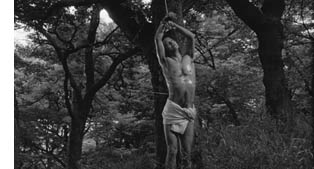 Nevertheless, I’d argue, the film has a marked trajectory. “Perfection of the life or of the art?” Yeats asked. Schrader’s Mishima wants both, together. He seeks to fuse physicality (eroticism, violence, endurance of pain) with spirituality (given as the realm of art). The emblematic image is the poem written in a splash of blood. He finally realizes that for him this fusion can come only in death, because his life has come to embody, literally incarnate, his literary themes and techniques.
Nevertheless, I’d argue, the film has a marked trajectory. “Perfection of the life or of the art?” Yeats asked. Schrader’s Mishima wants both, together. He seeks to fuse physicality (eroticism, violence, endurance of pain) with spirituality (given as the realm of art). The emblematic image is the poem written in a splash of blood. He finally realizes that for him this fusion can come only in death, because his life has come to embody, literally incarnate, his literary themes and techniques.
Schrader’s film enacts the blending of art and life in its very imagery. At the climax, in the biographical strand Mishima climbs into a jet and the black-and-white imagery gains radiant color as he stares into the sun. The shift brings the biography up to 1970, and so provides a transition to the color footage of the writer’s last day, but it also recalls the opening credits, with the sun rising, and the closing shot of the cadet Isao about to slash himself.
Schrader regrets the transition showing Isao running to the beach, because the imagery shifts from Ishioka’s stylized world to something more realistic (albeit with glowing amber rocks). So for the upcoming Criterion DVD release he has fiddled with the final shots so that the sun and sky look far more abstract. Evidently he wants the world of art and the world of life to remain stubbornly apart—denying to his film what his protagonist yearned for.
You might object that the film’s formal intricacy and specialized themes make for a fairly chilly experience. It isn’t a wildly emotional movie, that’s true; it has some of that ceremonial, contemplative quality you get from a Philip Glass opera, which provides a theatre of pictorial attitudes rather than action. (For an example, see coverage of the current Met production of Glass’s Satyagraha.) No coincidence that Glass provided the score for the film, which he wrote without seeing any footage and which Schrader cut and shuffled to provide cues. Glass obligingly rescored the film to fit the musical collage Schrader wanted.
The film provides a visceral and a sensuous experience, but it doesn’t carry you off on waves of emotion. It will never be popular on a massive scale, because it makes almost no concessions to what people like in biopics. But if you can adjust yourself to a solemn celebration of blood and beauty, Mishima offers unparalleled rewards.
More from Schrader
“Inspiration is just another word for problem-solving.”
Schrader’s intellect never lets up. What other filmmaker could produce such a thoroughly informed academic case as he does in the 2006 “Canon Fodder” (available on his site)? One on one, I peppered him with questions and he answered with seriousness and subtlety. Two themes ran through his comments: his approach to direction and his view that cinema is dead.
On his directing: Until his last project, he embraced the “well-made film.” He shoots with a single camera, and plans his takes cut to cut. (That is, not a lot of coverage from many angles that will be winnowed out during editing.) He doesn’t storyboard because he wants to develop the staging organically on site. He visits the set, tries out blocking with the actors and DP, then decides on the spot about the breakdown into shots. For the Temple of the Golden Pavilion scenes of Mishima, like the one above, he and cinematographer John Bailey played “dueling viewfinders,” pacing around the actors to test points of view and then settling on tracking shots which incorporated the best angles.
But for his latest project, Adam Resurrected (2008), Schrader switched to a rougher style. Now, he says, he uses two cameras and he likes the bouncing and swaying frame yielded by the Bungee Cam. “I’m sick of the well-made film.”
On new media: Schrader’s stylistic turnabout comes from his conviction that cinema, “the dominant art form of the twentieth century,” is coming to an end. Today’s audience demands new forms of moving-image media. Thanks to television, young people have seen every conceivable story, so narrative is “exhausted” as an expressive resource. They expect their media products to be free, available on demand, and interactive. The result is a challenge to traditional media on every front: financial, cultural, and artistic.
Schrader looks to the Internet as not just an intriguing option but film’s destiny. So while he is planning a traditional “three-act” film, he also has written a screenplay for a 75-minute Net movie. In his essay, “Canon Fodder,” he predicted the end of traditional cinema but thought that he could keep going before the revolution. Now, he says, the sun is setting faster than he expected and if he wants to make more films he has to adjust.
I’m no prophet, but I don’t share his beliefs about the imminent collapse of traditional cinema. I also think that Web-based films, with viewers tempted to browse and graze and fast-forward, will limit aesthetic options. The computer monitor is not as hospitable to contemplative cinema, which demands that the audience patiently submit to unfolding time. When I worried at a panel that an Ozu or a Bresson could not have originated in the age of YouTube, he told me, “Get over it, David!” Though we disagree, talking with him was terrifically stimulating. I left with the hunch that Schrader will continue to devise some characteristic provocations for new media, for which we should be thankful.
Envoi
Dusty Cohl was one of the mainstays of Ebertfest, as well as the founder of the Toronto Film Festival and a shot in the arm to world film culture. He died last fall. He was honored by several events at this year’s festival, notably the biographical film, Citizen Cohl: The Untold Story, by Barry Averich (The Last Mogul). On my first visit to Ebertfest, the tough, salty guy with the quick grin and the cowboy hat immediately made me feel welcome, and he did the same when Kristin came along the following year. Everyone whose life he touched was grateful for Dusty’s generosity of mind and spirit.
Fair is still fair, and more so
Film Art: frames from Election illustrating the concept of motifs
Kristin here—
Back in 1977, when David and I began writing Film Art: An Introduction, we knew from the start that we would use frame enlargements as illustrations. At the time, that wasn’t common practice for film books, even textbooks. One reason was that it was difficult to obtain such images, but perhaps even more daunting was the notion that using frame enlargements would violate copyright. But Film Art came out of classes we had been teaching, and there we used slides of frames and 16mm clips during lectures to illustrate cinema techniques, style, and form. We didn’t see any way we could write it without photographing and reproducing actual frames.
From the start, we assumed that using frames in an educational context would be fair use. A few frames from a film would be comparable to a few words from a poem or a novel, we figured. We didn’t request permission to reproduce most of the frames printed in the book. The exceptions were films by experimental filmmakers, whom we asked more out of courtesy than because we figured we legally needed to.
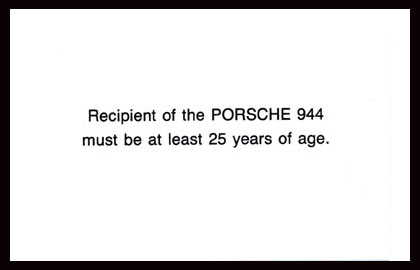 One pleasant incidental result of such requests was that we now have autographs from Norman McLaren, Michael Snow, Ernie Gehr, and Bruce Connor. These unfortunately are on dull request forms. Connor livened his up a bit by adding, “I own the splices on my films. The images from individual frames are not copyrighted by myself.” He also enclosed the accompanying card as a little surrealist gesture.
One pleasant incidental result of such requests was that we now have autographs from Norman McLaren, Michael Snow, Ernie Gehr, and Bruce Connor. These unfortunately are on dull request forms. Connor livened his up a bit by adding, “I own the splices on my films. The images from individual frames are not copyrighted by myself.” He also enclosed the accompanying card as a little surrealist gesture.
We never got in trouble with the copyright holders for reproducing the hundreds of frames in Film Art. Most of our other books have also involved frames, from Méliès shorts to The Lord of the Rings.
The 1993 Report on Fair Use and Film Stills
Initially some of our editors were a bit reluctant to include those frames unless we obtained permissions from the copyright holders, but we managed to talk them into it. Then, in the early 1990s, I was asked to chair a special committee of the Society for Cinema Studies (now the Society for Cinema and Media Studies) to investigate the question of fair use of film frames and photographs. The result was the “Report of the Ad Hoc Committee of the Society for Cinema Studies, ‘Fair Usage Publication of Film Stills,’” written by me with help from my colleagues John Belton, Dana Polan, and Bruce F. Kawin. Experts, including the Register of Copyrights, Ralph Oman, and Prof. Peter Jaszi, an expert on copyright law, contributed their thoughts on the matter. The report first appeared in the Winter 1993 issue of Cinema Journal and is available online.
The fair-use law itself is simple. Here are the factors to be considered in determining whether the reproduction of a work violates its copyright:
1) the purpose and character of the use, including whether such use is of a commercial nature or is for nonprofit educational purposes;
(2) the nature of the copyrighted work;
(3) the amount and substantiality of the portion used in relation to the copyrighted work as a whole; and
(4) the effect of the use upon the potential market for or value of the copyrighted work.
That last one seems to me particularly important for scholars, since it would be very difficult, if not impossible to prove that anything we publish diminishes the market value of the original. Quite the contrary, we help in our own small way to publicize that original.
I argued in the report that fair use did apply to film frames used in an educational context. The case for reproducing publicity and other behind-the-scenes photographs was considerably less clear, since unlike film frames, photographs can be individually copyrighted.
The report has had salubrious effects on film publications. Slowly more journal and academic-press editors accepted the idea that fair use does mean that authors don’t need to seek permissions. Given that most big studios either ignore such requests or demand hundreds or even thousands of dollars for their consent, the new policies of many journals and presses was a great boon to cinema studies. Gradually more and more scholarly and educational publications used frames instead of publicity stills, which made their descriptions and analysis much more effective. By now the use of film frames has become common practice.
Some encouraging cases
Occasionally, however, someone who is nervous about using frames writes to me to ask if anything has happened since 1993 that would change the situation. Has anyone been sued by a film studio for using film frames? Has a precedent been set?
In the report, I predicted that no studio would ever sue over the academic use of film frames. That was partly because the studios have bigger fish to fry, particularly the huge question of how to prevent film piracy. In contrast to bootleg DVDs selling for a couple of dollars in the streets of Shanghai or Moscow, we film scholars do not figure in the consciousness of the studio legal departments.
There have been some events that I think make it worth revisiting the issue of fair use in a more informal way here.
First, the very fact that the use of frame enlargements has become so common and that fewer academics seek permissions from copyright holders itself sets a precedent. As I said, it’s common practice now. I assume there probably are still editors who would rather be safe than sorry and demand that the author obtain permissions for illustrations. I assume there are probably some authors who abide by that decision or who are themselves worried about copyright and so do seek and even pay for unnecessary permissions. As always in discussing this issue, I urge editors and authors not to seek permissions, since it sets a different and dangerous precedent, implying that fair use might not apply in such publications.
Second, there have been some interesting court cases which don’t involve film frames but which do suggest that fair use applies to the sorts of images that film scholars might wish to employ.
In August of 2006, a decision came down in the case “Christopher R. Harris v. San Jose Mercury News.” (See here for an article on the case from Communications Lawyer.) Like many other newspapers, the Mercury News had used a photograph from a book in a review of that book. The newspaper cropped the photo, including eliminating the copyright notice. Harris, the photographer, sued for infringement.
The closing argument was presented by Gary Bostwick, of the major law firm Sheppard Mullin Richter & Hampton, which works in, among other areas, entertainment law and intellectual property rights law. An abridgement of Bostwick’s argument for the reproduction of the photo as fair use is included in the article linked above. The article concludes: “The jury deliberated for only thirty-seven minutes before concluding that copying photographs from books for use in reviews was fair use.”
If a newspaper review can reproduce photographs, surely a scholarly book could claim an even greater right to do so.
Recently I sat down with my friend and colleague, James Peterson, of Godfrey & Kahn, S.C., who practices intellectual property rights law here in Madison. James got his Ph.D. in film studies at the University of Wisconsin. His dissertation (the committee for which David co-chaired along with J. J. Murphy) was subsequently published as Dreams of Chaos, Visions of Order: Understanding the American Avant-Garde Cinema (Wayne State University Press, 1994). The book contains frame enlargements, obviously vital in any attempt to analyze experimental films. James’s expertise in film studies and his subsequent law degree make him particularly attuned to the needs of scholars in the field and the rights involved in using images in academic publications.
During our conversation, I mentioned that many books using frame enlargements had been published since the SCS report was published. James responded:
On the frame enlargements issue, to me, really, although there’s no case law verifying the old SCS analysis from twenty years ago, I think it’s right. I don’t have any reason to doubt it. Now, I have a personal commitment to it myself, because I relied on it when I did my book. Nothing in my experience as a lawyer has led me to think otherwise … I think the position on frame enlargements is much more secure than on production stills. Marginally more at least.
I mentioned that David and I had also used production stills in our books without seeking permission. James responded:
I would think that those are fair, too. To me the biggest case is the Bill Graham Archives case (the district court case in the letter) and that was affirmed right down the line by the second circuit court of appeals. So to me that’s a huge fair-use case for scholars.
The case James refers to is one he cited to me in a letter summing up his opinions on the fair-use status of various kinds of illustrations that I wanted to use in The Frodo Franchise. The second circuit court of appeals he refers to is in New York, and it often handles major cases involving copyright law.
The case in question was “Bill Graham Archives v. Dorling Kindersley Limited, Dorling Kindersley Publishing, and RR Donnelley & Sons Company.” At issue were some illustrations in a book, Grateful Dead: The Illustrated Trip. This was a coffee-table cultural history of the band, done with the members’ cooperation. The book reproduced without obtaining permission seven images on which the Bill Graham Archives claimed copyright. There had in fact been some negotiations between the publishers and the archive, but as a fee could not be agreed on, the illustrations were reproduced without permission. The copyrighted images had been “originally depicted on Grateful Dead event posters and tickets.”
The court decided in favor of the publishers, declaring the reproduction of the seven images constituted fair use and thus upholding the lower court’s decision. In summing up, the court declared (using the four factors determining fair use listed above):
On balance, we conclude, as the district court did, that the fair use factors weigh in favor of DK’s use. For the first factor, we conclude that DK’s use of concert posters and tickets as historical artifacts of Grateful Dead performances is transformatively different from the original expressive purpose of BGA’s copyrighted images. While the second factor favors BGA because of the creative nature of the images, its weight is limited because DK did not exploit the expressive value of the images. Although BGA’s images are copied in their entirety, the third factor does not weigh against fair use because the reduced size of the images is consistent with the author’s transformative purpose. Finally, we conclude that DK’s use does not harm the market for BGA’s sale of its copyrighted artwork, and we do not find market harm based on BGA’s hypothetical loss of license revenue from DK’s transformative market.
James expressed his opinion about the decision: “At least on the use of illustrative material, I think that case is very powerful.”
Powerful indeed, because it suggests that film scholars would be justified under fair use even if they reproduced whole production photos, posters, and other visual material directly related to the discussion in the text of their book or article, all without seeking permission.
I mentioned the widespread use of frame enlargements and photographs on the internet, particularly on fan websites. James gave his opinion on the use of photos on websites and then on our blog particularly:
The stock-photo houses are best positioned to complain about that activity, because they’re in the business of selling into that market. So if you want to illustrate something on your website, you shouldn’t just snatch it and stick it on the website.
You guys are, to my way of thinking–what you are doing is almost infringement-proof, because you’re unimpeachably scholarly and you’re writing about the things that you’re copying. It would be different if you were just using it to illustrate your website. I think a lot of the fan sites might fall into that category. They’re not connecting scholarship about the thing. They’re using the things they’re copying to attract attention to their own work. That, I think, is a different enterprise.
All of this is good news for cinema studies. So yes, things have happened since 1993 that would change the situation for film scholars, and it’s all for the better. Fair use is obviously alive and well, and those of us who need to reproduce the images we discuss can do so. Let’s all go analyze a film!
Note: Important policy statements on fair use in related areas have been released in the past few years. For the use of copyrighted material in documentary films, see the Center for Social Media’s “Documentary Filmmakers’ Statement of Best Practices in Fair Use” (2005) and its follow-up on the statement’s impact.
In 2007, the Society for Cinema and Media Studies released a statement targeted at classroom teaching: “The Society for Cinema and Media Studies’ Statement of Best Practices for Fair Use in Teaching for Film and Media Educators,” in Cinema Journal Volume 47, no. 2 (2008) or online.
The boy in the Black Hole
PTU.
DB here:
Films from Hong Kong’s Milkyway company earn a lot of praise for their visual qualities. Shooting in Technovision, Johnnie To Kei-fung and other directors have created some of the most vivid and fluid imagery in contemporary cinema. But the movies have soundtracks too. What about them?
When I saw Tsui Hark’s Time and Tide (2000), I staggered out exhausted. I was overwhelmed not only by the delirious plot and its cascade of feverish imagery—who else puts the camera inside a dryer at a laundromat?—but also by what seemed to me the most elaborate soundtrack I’d ever heard in a Hong Kong film.
Shortly after seeing the movie, I visited the Milkyway headquarters and met Martin Chappell, the sound designer of Time and Tide. (For his credits and his company information, go here.) I figured that he could help me hear more in all movies, not just his own.
Years later, during my spring visit to Hong Kong, I got my wish. Martin gave me an interview and sent me several information-packed emails. As I’d hoped, he taught me to listen better.
At the console
Martin Chappell is a concussive burst of enthusiastic energy, an impression aided by the fact that he looks about sixteen. He loves moviemaking and sound design. Growing up in England, he started as a bass guitarist and audio fan, and he studied music and acoustics. When he graduated he worked in sound studios and became a roadie. After a year in Australia, he moved to Hong Kong and got a job in a radio station.
Soon he was working at TNT, creating sound effects for cartoons and dubbing American movies into Mandarin. Hired briefly away by MGM, Martin then shifted to Milkyway. His first effort there was helping on the mix for The Intruder (1996).
Now, with over fourteen years of audio engineering experience, he is sovereign of sound at Milkyway. Ensconced at the heart of Milkyway’s facility, Martin presides over what he calls the Black Hole. The company’s sound studio consists of several rooms, including a Foley studio that is a black hole within the Black Hole.
By Hollywood standards, these studios are minuscule. (Compare the mixing theatre I visited last year for 3:10 to Yuma.) As usual in Hong Kong cinema, work must be fast and tight. Martin typically has a sound crew of three, sometimes including Foley artists. Postproduction sound is usually allotted three weeks, sometimes a little longer. Often he has to prepare a mix on short notice so that visiting critics, festival programmers, or backers can preview a work in progress. As a result, Martin can be found in the Black Hole far into the night, blasting through reel after reel.
Waiting for no man
Most Hong Kong films have a bare-bones approach to sound: dialogue, music, and minimal effects. The sort of detailing that Hollywood offers, especially in Foley techniques, has not been common. There simply isn’t the time and money for a densely mixed track. A lot of time has to be allotted for dubbing the film twice, once in Cantonese and once in Mandarin for the mainland and overseas Chinese market. As a result, even the best Hong Kong films often have a dry, vacant ambiance, which is commonly masked by music. (Perhaps the wall-to-wall music in Wong Kar-wai’s films is an effort to supply a rich sound texture in the absence of other options.)
But Time and Tide had more resources. As part of a Sony initiative to expand into Asian production, which also yielded Crouching Tiger and Kitano’s Brother, it had a large budget by Hong Kong standards. Martin had three months for sound postproduction, “the longest schedule I’ve had in my life,” and a sound crew of eight.
Martin found Time and Tide “a beautiful learning experience.” Working around the clock under the tutelage of veteran postproduction supervisor Hui Koan (The Blade, The Legend of Zu), Martin was encouraged to take chances. He could create rich Foley tracks—remember the tinny ricochet of the little boy’s abandoned skateboard?—and he borrowed ideas from Fight Club, Gladiator, and The Matrix. He was layering sound in the Hollywood manner, albeit on a smaller scale. And he pushed toward wilder possibilities. He recalls the pleasure of putting jungle bird calls under early shots of clubbers wandering through nighttime traffic.
Out and about
Hong Kong looks lovely, but Martin thinks that it’s just as breathtaking in its noise—“a rich sonic soup.” Virtually every chance he gets, he heads out to record in the field.
I pretty much never leave home without my Edirol R-09, and I have a Zoom HR for portable hard disc recording.
It’s important to have a recorder with you all the time. You never know when some drunk is going to burst into song whilst lying in the gutter. In Sparrow, Simon Yam challenges Ka Dung to steal the cop’s handcuffs when they’re outside a bar late at night. So I just pulled the recording I’d made earlier of some drunk guys singing karaoke. It was late one night, I was walking back from the pub, and I heard it echoing out an alleyway.
I feel I’m incredibly lucky. I went out one night to get fresh recordings of a minibus for Linger. I’d scouted the spot, but when I got there the heavens opened and I didn’t have an umbrella. I ran to a nearby bridge—serendipity. I realize it’s next to a tram road, so I recorded buses and trams in the rain, and these sounds feature prominently in Sparrow.
Martin’s wife Marisha often comes with him, either operating or providing effects herself. Recording on the fly freshens up his library, and keeps him alert to new possibilities.
I’m always hoping for a gift from the Ear in the Sky. I’m actually trying to type quietly now, but there’s a band playing downstairs and it’s coming through the walls. They sound terrible, but I think it could be used for a bar scene—late night outside somewhere? . . .
You can see Martin on location in a two-part TV show here.
Back in the studio, Martin revels in software like his Digital Performer and Propellerhead Reason programs. His setup isn’t a Mercedes, like ProTools, he says, more of a Lexus—but in some ways it’s more flexible than the more famous option. Johnnie To wants rich tracks, so “Now I spend almost all my time on Foley and ambience.” Martin “finds the flavor” of the sound through his synthesizer.
I load a recording into Reason and I can play with it in real time on my keyboard—pitching it up or down, sweeping the filters, tweaking the equalization. I do so much with ambiance like this. Sometimes I tie it to the picture, other times I just play on a whim. . . . It’s almost fun.
Alongside his high-tech equipment, Martin employs some home-made items, such as his gobo panel, an upright mesh of stones that is virtually a sculpture (above). The gobo can muffle or redirect sound. Placed between two sources, it can allow clean recording of each track.
Every gun makes its own music
In The Mission, each of the five bodyguards gets a different pistol. Martin gave each one a different sound, labeled in his files by the actor’s name. Here “Roy’s gun” is sometimes coded as “loy’s gun,” and there are plenty of other discrete sound bits on file.
I asked Martin about the mall shootout, which has become a classic in the genre.
There seemed to be so much space in there, and we were adding artificial reverbs, but none of them seemed to work real well. That’s when we decided to experiment a bit, developing things we’d tried in A Hero Never Dies. We just put in the tail of a cannon firing. So that phrase “Bring out the big guns” is literally true here.
There was also a really long gap between some gunshots. We tried adding more, but it felt too busy. So we tried lengthening each gunshot, with the cannon tail reverberating. But that still wasn’t long enough, so we started playing with it, almost jamming with the music. We time-stretched the cannon tails, not just a bit like you’re supposed to. It gave a very artificial but tense sound. If you think it’s music, it might well be.
But even then it wasn’t long enough. So before the next pistol shot, we actually reversed the cannon sound. We get the reversed echo first, then we hear the shot itself! It feels like time has slowed down, then speeded up.
Martin might also have mentioned that these wavering gun reports swoop across left and right channels, creating a dynamic acoustic space for cinema’s most static static gunfight.
Martin also shared his thoughts on the role of sound in fleshing out characterization. After reading Walter Murch’s book In the Blink of an Eye he began to think about how to use sound subjectively. The result was the PTU scene in which Lam Suet, head bandaged, smoking in his car, suffers auditory hallucinations.
Martin acknowledges that there are plenty of conventions that audiences would miss if they weren’t present. When a character hangs up the phone on another character, the disconnected line is signaled through a beep or hum, even though this seldom happens in real life. Martin would also like to hear mobile phone calls in that “headphone bleed-through” effect. He’d also like to handle dialogue like that, “half-overheard, not fully comprehended.”
Still, he finds ways to bypass conventions. In PTU, when the officer played by Simon Yam is abusing the suspect in the video arcade, Martin avoided the library whacking sound, what he calls “the Foley kung-fu cloth flap.” Simon’s slaps are synched to explosions, whizzing missiles, and other arcade sounds. (I offer a visual analysis of one scene in PTU here.)
Ear in the sky
Martin believes that in most films, there’s an immediate need to establish the setting, the placement of the characters, and the scene’s mood. This is done through images, of course, but sound plays an important role. Often a wide shot orients us generally, while sound focuses on one zone of action in that space. “I would guess if you watch TV with no sound, it would be very difficult to really focus. Sound can bring out the visual and guide the eye.”
As an example, Martin walked me through a few moments in Sparrow. The elusive Chun Lei has gulled a quartet of pickpockets, and they pursue her to a rooftop. As the men explore it, we hear traffic and a distant plane, which evokes Chun Lei’s plan to flee Hong Kong.
They spot her on the roof. The suggestion that she might jump is underscored by distant traffic horns.
As the men approach Chun Lei, Martin added distant sirens and a soft wind.
An extreme long-shot provides a still broader sound canvas, with traffic sounds predominating.
In a much tighter shot, as the actors come closer to the camera, the ambiance thins and softens. “Now we time the traffic to underline the dialogue.” Chun Lei leans forward to kiss Bo, trying to provoke the leader Kei to jealousy. We hear echoes of a passing truck, almost as a warning.
Only professionals would probably notice these maneuvers, and there’s a reason. Martin thinks that sound can bypass the conscious mind, working directly on our most visceral impulses (fight or flight?). In this he echoes Gary Rydstrom, quoted in an earlier blog of ours: “Film sound is the side door to people’s brains.”
I’m grateful to Martin for all the time and effort he put into our interview. Next time I see a Milkyway film, or any movie, I’ll listen harder. You too?
Photo by Martin Chappell.
Goodbye to Hong Kong for another year
My Heart Is That Eternal Rose.
DB here, yet again:
Back nearly a week from Hong Kong, I’ve been swamped by backlog and made logy by jetlag. But I wanted to offer last-minute notes from this year’s film festival. I won’t comment on the films that disappointed me or that weren’t in finished form. Instead, upbeat reports, some pictures, and a trio of DVD delights.
On the big screen
Little Cop (1989) starring and directed by Eric Tsang, was part of the festival’s tribute to him. It’s a silly but ingratiating item that anticipates Stephen Chiau’s mo lei tau nonsense comedy. The opening credits are burned onto Tsang’s pudgy body, and thereafter a series of episodes takes him to the anti-prostitution squad (cue the condom jokes) and then the drugs detail. There are engaging gags around a funeral, with a song in praise of death set to the Colonel Bogey march, and lots of intrigue with a master criminal who can steal other people’s faces. Needless to say, since this is Hong Kong, we get many food gags too. Eric called in his bets and got a flurry of walk-ons from top stars like Andy Lau and Maggie Cheung. The only tedious stretch is the last scene, an uninspired clone of Steve Martin’s Absent-Minded Waiter routine. Otherwise, good dirty fun.
Paranoid Park (2007) seemed to me Gus van Sant’s best film in a long time, after the somewhat arid exercises of Gerry and Last Days. Here he’s got a genuine, gripping story that he can render in his detached but lyrical style. The shot of Alex in the shower is particularly gorgeous, and the tracking shot of his tormented walk through town is enhanced by swarms of subvocal recriminations that spurt out from all three channels. My friend J. J. Murphy has provided further commentary on his blog here and here.
If movies about moviemaking risk narcissism, movies about film school must be narcissism squared. The Early Years: Erik Nietzsche Part 1 (2007) centers on a young filmmaker who is transparently Lars von Trier. In-jokes about Danish film culture pile up, and the plot takes almost every easy way out, but Jakob Thuesen keeps the proceedings moving briskly enough. The caricatures are fun, although I think the all-night frenzy of film school life is better captured in Yanagimachi Mitsuo’s Who’s Camus Anyway?
A real revelation: And the Spring Comes (2007, above), by Gu Changwei. A somewhat homely woman with a crystalline singing voice imagines herself headed straight for the Beijing opera. Instead, broken love affairs and unwillingness to lower her ambitions keep her sequestered teaching music in a small town. A tough but touching melodrama rendered in a tactful style, with female lead Jiang Wenlei willing to be unsympathetic.
Many art movies can seem inert in their storytelling—over-under-dramatized, we might say. Carlos Reygados’s Silent Light (2007) escapes this trap. Slow and static, it is suffused with a stark calm that gives gravity to a love affair between a stolid farmer and a woman who runs a café. Planimetric compositions are used imaginatively, and the soundtrack makes daring use of offscreen noises. As an old Dreyer fan, however, I have to worry about the film’s relation to Ordet. Dreyer’s film isn’t exactly ripped off or cited, but it floats behind this one like a spectre before materializing at the climax, perhaps in overbearing fashion. Ordet, suffused with religious debate, earns its miraculous finale, while Silent Light, for all its austerity, is a film of the flesh, and its spiritual coda seems to me somewhat forced. But I’m willing to be convinced otherwise.
Because another guest didn’t appear, I was asked to introduce programs of films by or related to Maya Deren. I enjoyed the chance to see them again, and to reread her writings in the excellent collection Essential Deren. Her work remains stimulating—especially Meshes of the Afternoon and Ritual in Transfigured Time. Her writings blend a stringent formalism, echoing Rudolf Arnheim‘s views of cinematic specificity, and a fascination with myth and non-Western cultures. The boys’ Trance movies (Fragment of Seeking, The Cage, The Potted Psalm) are of historical interest, but hers remain lively. I was happy to see how many young people stayed after the screenings to discuss films that are sixty years old.
On the small screen
In my shopping, I discovered three fine movies on DVD.
*Do Over, a Taiwanese network narrative I liked in Vancouver back in 2006, now available with English subtitles in a so-so transfer (good color and contrast, blurry frame-by-frame pickup). A strong debut film from Cheng Yu-chieh.
*My Heart Is That Eternal Rose, an important 1989 Hong Kong film by New-Wave talent Patrick Tam. This mix of romance and crime stars Kenny Bee, Joey Wang, and a shockingly young Tony Leung Chiu-wai, and Christopher Doyle is listed as one of two cinematographers. The film’s daring stylization marks it as belonging to Hong Kong’s late-80s burst of creativity, and many moments look forward to the luxuriant melancholy of Wong Kar-wai. Clearly Tam (who edited Days of Being Wild and Ashes of Time) was an important influence on Wong. For a long time, I had access to My Heart only on an ugly pan-and-scan laserdisc, but now a widescreen transfer of a worn but bright print offers a considerable improvement. It’s far from perfect, with somewhat slurred movement, but better than nothing.
*Play while You Play, usually known as Cheerful Wind (1981), is Hou Hsiao-hsien’s second film, a romantic drama about a blind man and a somewhat self-indulgent television producer. It’s one of his three commercial “musicals,” and seldom seen, let alone discussed. I think that stylistically these films lay the groundwork for his Taiwanese New Wave films from The Sandwich Man onward. (Go here for more.)
I don’t enjoy this quite as much as his first film, Cute Girl, or his third, The Green, Green Grass of Home, which seems to me nearly a masterpiece. Still, there are lovely moments in Cheerful Wind, including the music montages and a surprisingly offhand ending. Hou films almost casually in the open air, letting passersby drift in and out of the frame (above). The disc, from something called Hoker Records, claims on its package to be 4:3, but it actually preserves the 2.35 format. Unfortunately, it does so through letterboxing, yielding only so-so resolution. No English subtitles. Rumor has it that the irresistable Cute Girl is available in a similar package.
In the point-and-shoot LCD
Four of the brains behind the festival: Ivy Ho, Bede Chang, Li Cheuk-to, and Albert Lee.
Shan Ding, man of all work at Milkyway Image, and the magisterial Peter Greenaway.
Mrs. Johnnie To, Johnnie To, Amy Lau, and Lau Ching-wan, who normally eats nicely.
Joanna Lee, translator extraordinaire and music facilitator to the world.
Jupiter Wong, ace photographer, and Bela Tarr after the enthusiastic reception of The Man from London. My takes on Tarr are here and here and here.
Peter Chan, whose Warlords just won a slew of prizes at the Hong Kong Film Awards.
Jacob Wong, Festival programmer, and Raymond Phathanavirangoon, lately of Fortissimo. I praised Raymond’s presskits last year.
Shu Kei and Michael Campi, just before the premiere of Coffee or Tea, which Shu Kei directed with Kwan Man-hin.
Tourist snap no. 1: Wherever you turn in Wanchai, there’s something interesting to see. Even air conditioners start to look like public sculpture.
Tourist snaps 2 and 3: I often took the Wanchai ferry to screenings on Kowloon.
Tourist snap 4: Coming back late from a screening on the Kowloon side, I would walk past the old clock tower.
. . . A walk fortified by a late-night sample of the Sweet Dynasty’s almond and walnut soup.
In all, as I said at the start of my 3 1/2 weeks here: This will always be the place.












